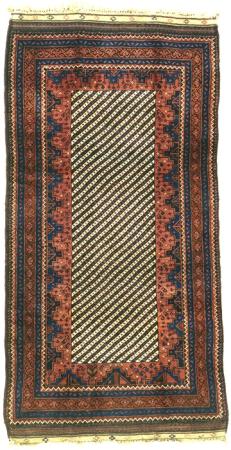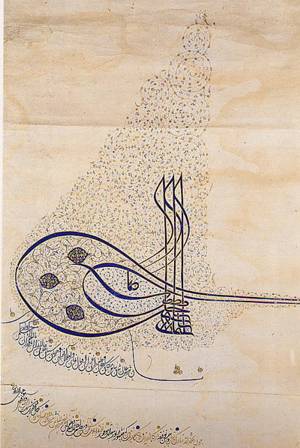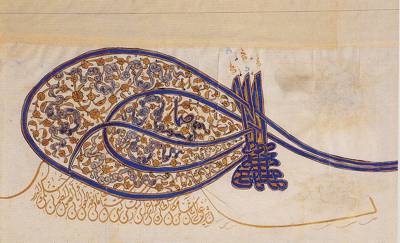The Salon du Tapis d'Orient is a moderated discussion group in the manner of the 19th century salon devoted to oriental rugs and textiles and all aspects of their appreciation. Please include your full name and e-mail address in your posting.
by Steve Price
Dear Readers,
I would like to introduce you to a recent addition to our household.
The colors on my monitor are not accurate; they are somewhat brighter and more "orange" in person.
In addition to the fact that I like the aesthetics very much, I think this is an interesting rug, which is why I chose to use it as the springboard for this Salon discussion.
Fields with diagonal stripes are not unusual in Caucasian rugs and bags, but very uncommon in Belouch group rugs. In fact, I haven't found a single published example of a Belouch (or any other tribal) rug with such a field design. Perhaps there is one in print that I've missed, but it is unlikely that there are many of them. Here is one that was listed awhile ago as part of a dealer's inventory on the web. Since it may still be on the market, I don't want to discuss the two from a standpoint of comparative desirability, but show it as the only other image of an example that I have found from this small group. Perhaps some of our readers will have images of others.

One very provocative element of my specimen (the first illustration) is the change in direction of the stripes. The weaver began (at the bottom) with stripes rising diagonally from lower right to upper left, then reversed their direction in the lower part of the field. Changes in design or dimensions of elements of a rug are unusual, but by no means rare, and we generally interpret them as reflecting a weaver's recognition that things would look better or work out better with the modification. That is, the weaver changed her mind about what she intended to do or corrected an error in judgment after beginning the weaving and seeing how things looked. That can hardly be the explanation in this case. The aesthetic of the piece with stripes diagonally running lower right to upper left would be the same as that with stripes running in the other direction. Clearly, the piece invites us to revisit the notion that such changes are done on the basis of decisions made by a weaver who is not satisfied the result of with her original plan.
Another interesting aspect of how the stripes change direction is that it does not begin at the same weft across the width of the rug. It is apparent that the direction change occurs first in the lower left, and is made progressively later (that is, further up in the weaving) as we move across to the right. This is quite different than the changes I am accustomed to seeing in the early part of a rug, which always seem to be rather abrupt. This, too, suggests that the design here is something that was planned before the weaving began. If this is the case (something I think is very likely), the rug represents an extraordinary level of originality and innovation on the part of the weaver.
Notice the rather smooth curve of the stripes as they change direction. Curves are pretty uncommon in tribal textiles, and they give this one a most unusual character. Indeed, they remind me of the smooth, sweeping curved forms of tugra. Tugra are the signatures of Ottoman sultans drawn by court calligraphers on official documents. They are virtually an art unto themselves.
Here are images of two of them. Of course, the visual relationship to the field design in this rug is not an adoption of the tugra form by the weaver, and there is no historical relationship of the rug's field to tugra. But I have long admired the sultans' official signatures as perhaps the apex of the art of calligraphy, and I think this is part of the reason that I find this rug so attractive and interesting.


Finally, it raises the issue of attibution of Belouch group rugs. It is knotted asymmetrically, open to the right, and this characteristic, plus the palette and end finishes, places it within the group that is generally referred to in the marketplace as Arab Belouch. I would be interested in anything anyone can contribute to clarifying the basis for that, and for other attributions made within the Belouch weavings.